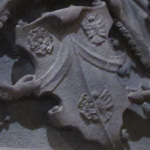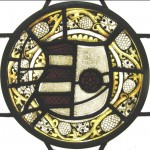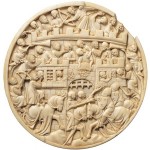Friday, October 21, 2011
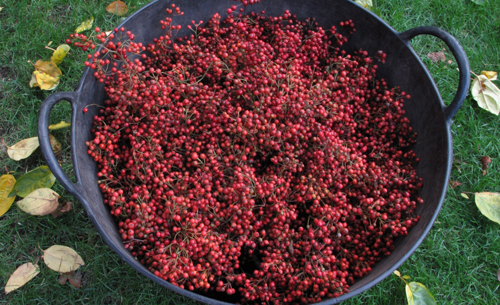
A tub of rose hips, gathered from roadsides and abandoned pastures upstate, and stripped of their thorns. The hips will be used to decorate the Museum this winter. Photograph by Carly Still
The rose hips used in the winter holiday decorations at The Cloisters allude to the rose symbolism prevalent in medieval Christmas carols. Although we grow medieval rose species in the gardens and on the grounds, their hips are too fleshy for our purposes, and don’t keep well.?? We gather stems of Rosa multiflora, which bear many small, hard, hips, in October, and strip them??of their thorns. They are stored in a cool, dry place until December, when the Museum is decked for the season.
Read more »
Tags: cattle, erosion, hips, Japanese rose, Rosa multiflora, rose, rose hip, weed
Posted by Deirdre Larkin on Friday, October 21 at 1:15 pm | Comments (1)
Wednesday, October 12, 2011
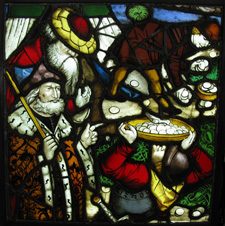
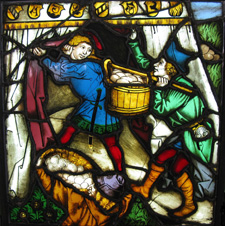
The marvelous food??depicted in these two panels of Late Gothic German stained glass may have been of vegetable origin. Left: Gathering Manna. Moses, holding the staff received from God on Mount Sinai, presides over the gathering of a miraculous fall of quail and manna from heaven. Right: Storing up Manna. Two men bear a large wooden tub of manna into a tent; a third man carries a great basketful in his arms.
The identification of Biblical plants has occupied investigators for centuries; the identity of manna is??one of??the most intriguing and most debated of ethnobotanical mysteries, although some interpreters have suggested that the substance is of insect rather than vegetable origin. Read more »
Tags: Albertus Magnus, algae, Avicenna, Bible, Circa Instans, Coccus manniparus, Exodus, Fraxinus ornus, Hortus Sanitatis, Lecanora esculenta, lichen, manna, Nostoc commune, Platearius, tamarisk, Tamarix mannifera
Posted by Deirdre Larkin on Wednesday, October 12 at 9:11 am | Comments (1)
Friday, September 23, 2011
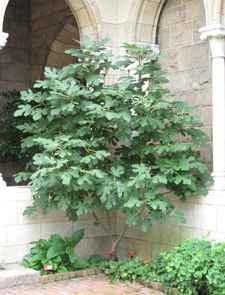

A young fig tree flourishing in a sheltered corner of Bonnefont garden; detail of the ripe fruit (click to see full image)???note the tiny hole in the base of the fig at the lower right, and the milky sap that exudes from the stems when the figs are picked.??This latex was a medicament and a rennet; it was also used as a mordant in medieval gilding and as a binder in the preparation of egg tempera.?? Photographs by Deirdre Larkin
So when the woman saw that the tree was good for food, and that it was a delight to the eyes, and that the tree was to be desired to make one wise, she took of its fruit and ate; and she also gave some to her husband, and he ate.
Then the eyes of both were opened, and they knew that they were naked; and they sewed fig leaves together and made themselves aprons.
???Genesis 3:6, 7
Much of the plant lore of the Middle Ages, like many other aspects of medieval culture, was a synthesis of classical and biblical tradition. The Tree of Knowledge is not named in the biblical account of the Fall; more than one species has been identified with the forbidden fruit, and the fig is among them. In Greco-Roman culture, the fig was associated with fertility and with the female genitalia. D. H. Lawrence??explores??this complex of cultural associations in his remarkable poem “Figs” (listen to a reading of this poem on YouTube).
Read more »
Tags: Adam, Alcinous, Athenaeus, Bugiardini, De Materia Medica, Deipnosophists, Dioscorides, Eisen, Eve, ficus carica, fig, forbidden, Genesis, Hildegard of Bingen, Pliny, Rumina
Posted by Deirdre Larkin on Friday, September 23 at 12:19 pm | Comments (1)
Thursday, September 8, 2011
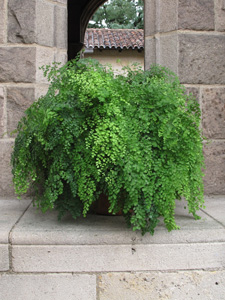
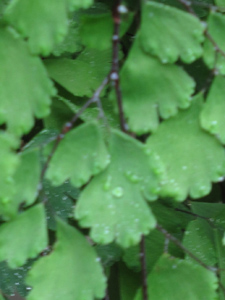
The lovely Venus maidenhair is not quite hardy for us at The Cloisters, and is grown in pots in the medieval gardens. The pinnules of this graceful fern, which flourishes in moist and rocky situations in many parts of the world, repel water.?? Photographs by Carly Still
The southern or Venus maidenhair (Adiantum capillis-veneris)??belongs to a large genus of ferns that includes two hundred species. The botanical name given to the genus Adiantum is from the Greek for “unwetted,” since any water falling on the foliage of these ferns beads up, leaving the leaf surfaces dry. This species was??already known by that name??in classical antiquity; the Roman natural historian Pliny marveled that a plant that grew in moist places exhibited such a marked antipathy to water. According to Pliny, the plant??was known to some as “beautiful hair” or “thick hair.”?? A decoction of the fern, made by??simmering it with celery seed in wine and oil, was used both to dye the hair and to prevent it??from falling out (Historia naturalis, Book XXII, 62???65). Read more »
Tags: Adiantum, baldness, Dioscorides, fern, Hortus Sanitatis, maidenhair, Maude Grieve, pinnule, Pliny, Rufinus, Salerno, stipe, Venus
Posted by Deirdre Larkin on Thursday, September 8 at 3:44 pm | Comments (5)
Friday, September 2, 2011
Plantagenet. Since you are tongue-tied and so loath to speak,
In dumb significants proclaim your thoughts:
Let him that is a true-born gentleman
And stands upon the honour of his birth,
If he suppose that I have pleaded truth,
From off this brier pluck a white rose with me.
Somerset. Let him that is no coward nor no flatterer,
But dare maintain the party of the truth,
Pluck a red rose from off this thorn with me.
???Henry VI, Part 1, Act 2, Scene 4
After the fleur-de-lis, the rose is probably the second most common floral charge to appear on heraldic shields. That’s quite understandable, since the rose’s emblematic associations ranged from the Virgin Mary to the Five Wounds of Christ to romantic love. In the military context of knights and noble families, the rose also suggested the fierce and often impenetrable thicket of prickled branches in which it grows. The white roses strewn around the fearsomely armed lion rampant that occurs on the shield of Finland might have raised just such an association in the minds of beholders. Alternately, roses might also have been chosen as a play on a name???the arms of the German town of Rosenberg in Baden-W??rttemberg, for example, or the Baltic baronial family von Rosen.
Read more »
Tags: fleur-de-lis, heraldry, roses, Shakespeare, Tudor
Posted by R. Theo Margelony on Friday, September 2 at 10:03 am | Comments (1)
Thursday, August 11, 2011
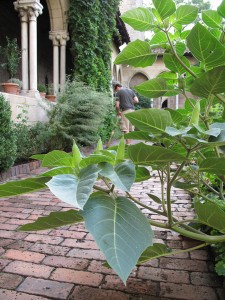
My early morning sweep of Bonnefont garden, overseen by the downy thornapple (Datura metel). Photograph by Corey Eilhardt
A quiet life has many rewards: not least of these
Is the joy that comes to him who devotes himself to the art
They knew at Paestum, and learns the ancient skill of obscene
Priapus???the joy that comes of devoting himself to a garden.
???From Hortulus by Walahfrid Strabo. Translated from the Latin by Raef Payne. The Hunt Botanical Library, 1966.
Read more »
Tags: Benedict, Benedictine, bryan_stevenson, ground ivy, internship, jasmine, monk, nightshade, nun, pear, potato beetle, spearmint, Walahfrid Strabo
Posted by Bryan Stevenson on Thursday, August 11 at 10:25 am | Comments (4)
Friday, August 5, 2011
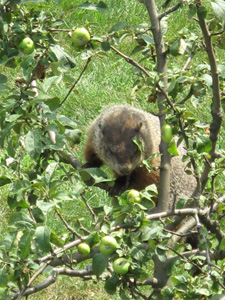
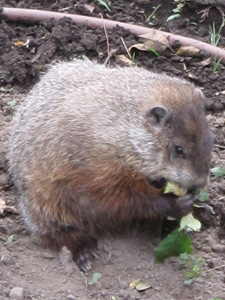
Woodchucks, also known as groundhogs, live in burrows but can and do climb trees. They’re particularly fond of apples. Photographs by Corey Eilhardt
How much wood could a woodchuck chuck,
If a woodchuck could chuck wood?
Woodchucks don’t chuck wood, except in tongue twisters and insurance commercials.
Woodchucks (Marmota monax), also known as groundhogs or whistle pigs, are rodents, as are more than half of the world’s mammalian species. They belong to the same family as the squirrel, although woodchucks live underground and squirrels nest in trees. The English name of this common North American mammal derives from the Alogonquian wuchak.
Read more »
Tags: apple, groundhog, Marmota monax, squirrel, woodchuck
Posted by Deirdre Larkin on Friday, August 5 at 10:04 am | Comments (9)
Thursday, July 21, 2011
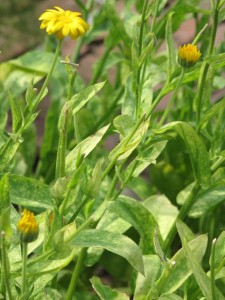
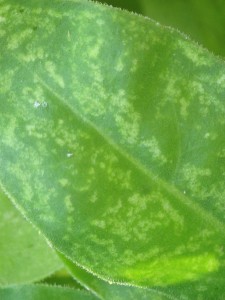
Left: A severe infestation of two-spotted mites on a calendula growing in Bonnefont garden. Right: A detail of the damage done by this common hot-weather garden pest, which sucks the chlorophyll from the leaves of the host plant. Photographs by Corey Eilhardt
The hot, dry weather that has us struggling to keep the gardens watered is all too welcome to the two-spotted mite, Tetranychus urticae, a worldwide pest of crop plants, ornamentals, and houseplants that is as much at home in greenhouses and apartments as it is outdoors. Two-spotted mites, along with other members of the Tetranychus family, are commonly known as spider mites. They are arachnids but are more closely related to ticks than to spiders.
Read more »
Tags: Bonnefont Garden, Calendula officinalis, catmint, hops, humulus lupulus, lady???s mantle, Levisticum officinale, lovage, meadow rue, Nepeta x faassenii, pest, Phytoseiulus persimilis, pot marigold, spider mites, Tetranychus urticae, Thalictrum aquilegifolium, two-spotted mite
Posted by Deirdre Larkin on Thursday, July 21 at 11:11 am | Comments (2)
Friday, July 8, 2011
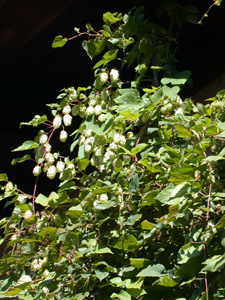
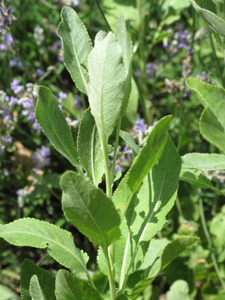
Hops (Humulus lupulus), considered today to be crucial to beer brewing, were not commonly used until the fifteenth century. Before that time, brewers added different herbs, such as??alecost??(Tanacetum balsamita), to their beer to improve its flavor. Several of these medieval brewing herbs can be found in Bonnefont garden.
Ale is made of malte and water; and they the which do put any other thynge to ale then is rehersed, except yest, barme, or godesgood, doth sofystical theyr ale.
???Andrew Borde, The fyrst boke of the introduction of knowledge, 1452
Beer was a staple drink for medieval Europeans, as it provided much-needed calories to the often undernourished population and was cleaner and safer to drink than water. Then, as now,??beer was made by brewing malted barley in boiling water to make sugars more available for yeasts to consume (see an image of Jorg Prewmaister tending his brew in a page from a fifteenth-century German manuscript, Amb. 317.2). This sugary, malty potion, known as “wort,” eventually becomes beer after the yeasts eat the sugars, releasing carbon dioxide and alcohol as byproducts of fermentation. On its own, wort is fairly flat in flavor, so brewers add additional ingredients, such as hops and spices, to enliven a beer’s taste.
Read more »
Tags: Achillea millefolium, Add new tag, ale, alecost, barley, beer, brew, bryan_stevenson, costmary, Glechoma hederacea, ground ivy, gruit, hops, humulus lupulus, Ledum palustre, malt, Myrica gale, Reinheitsgebot, stinging nettle, sweet gale, Tanacetum balsamita, Urtica dioica, wild rosemary, wort, yarrow
Posted by Bryan Stevenson on Friday, July 8 at 1:12 pm | Comments (3)
Friday, July 1, 2011
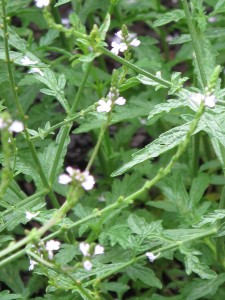
The medieval vervain was identified with the “holy herb” known to the Greeks and Romans. Despite its unprepossessing appearance, common vervain is one of the great magico-medical plants of the Western tradition.
Many odde olde wives tales are written of Vervaine tending to witchcraft and sorcerie, which you may read elsewhere, for I am not willing to trouble your eares with supporting such trifles as honest eares abhorre to heare.
???John Gerard, The Herbal or Generall Historie of Plants, 1597
Read more »
Tags: Pliny, Verbena officinalis, vervain
Posted by Deirdre Larkin on Friday, July 1 at 10:55 am | Comments (0)








